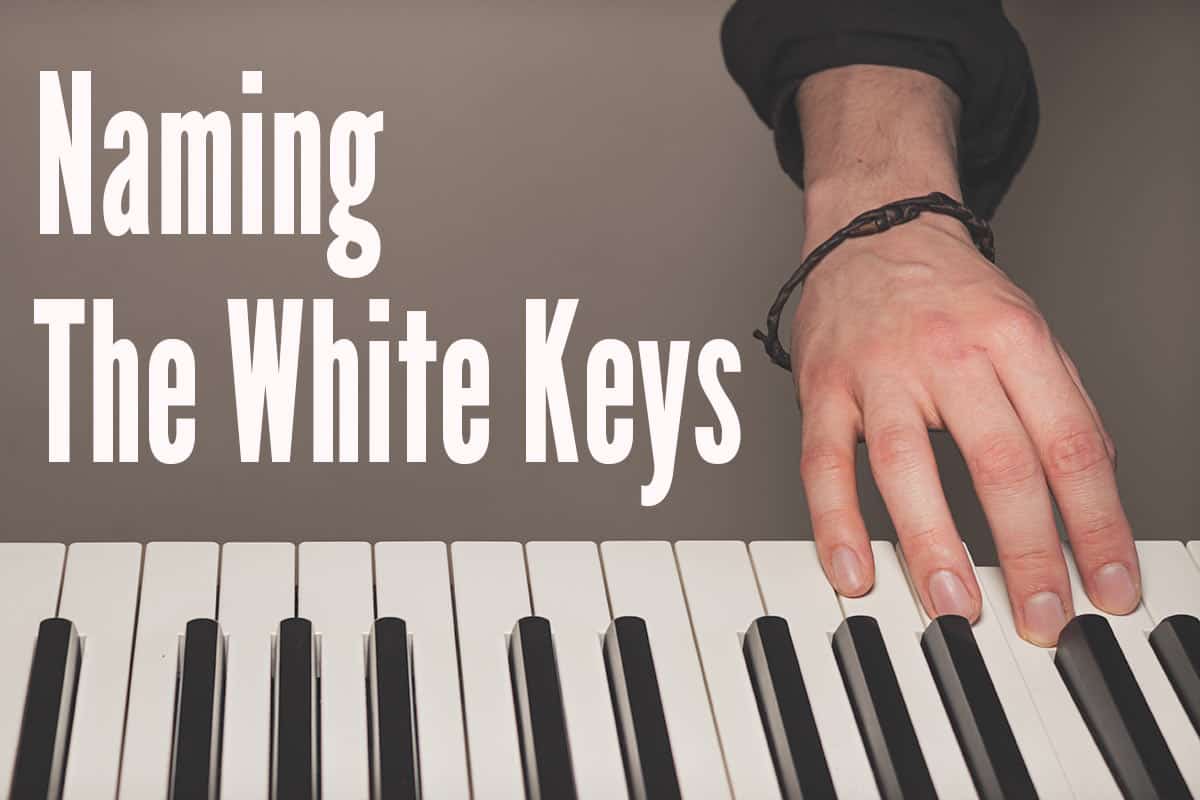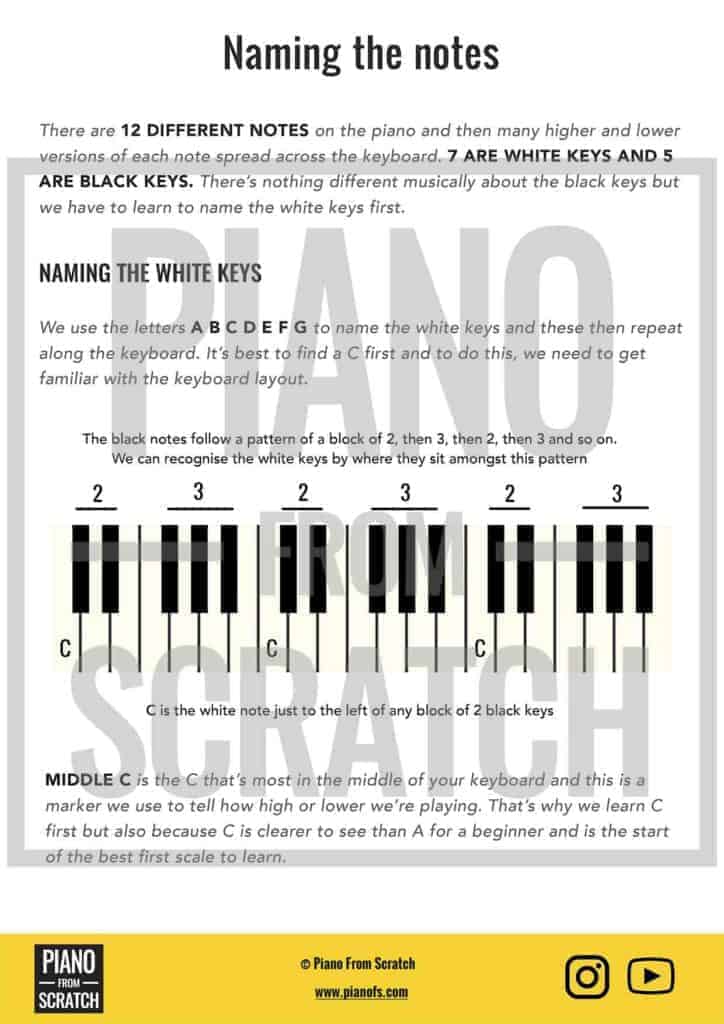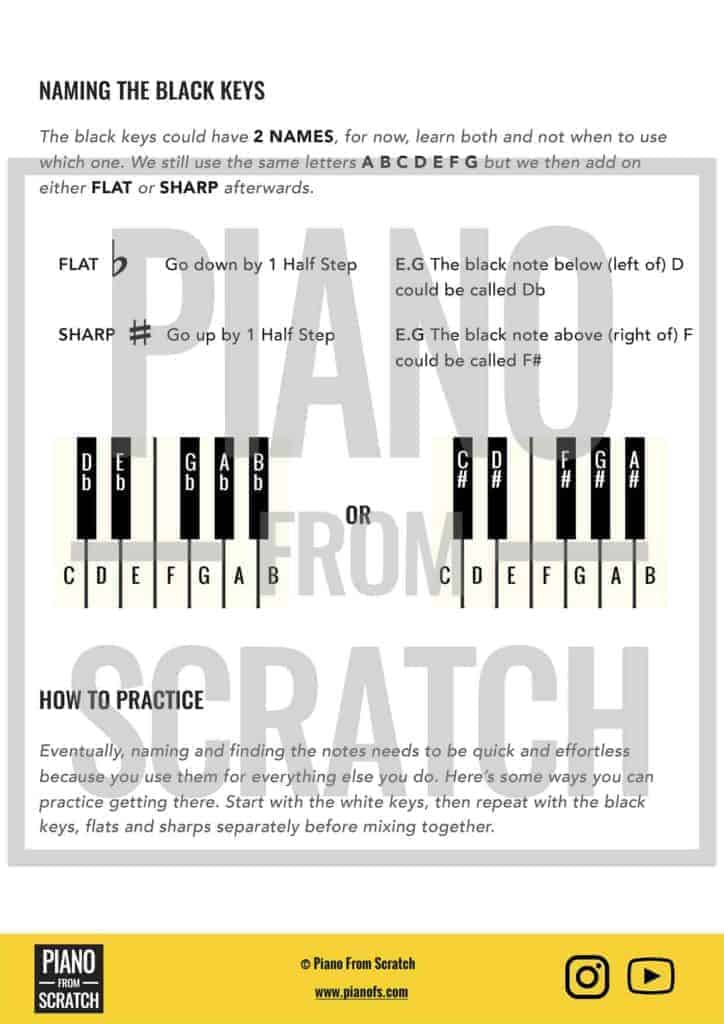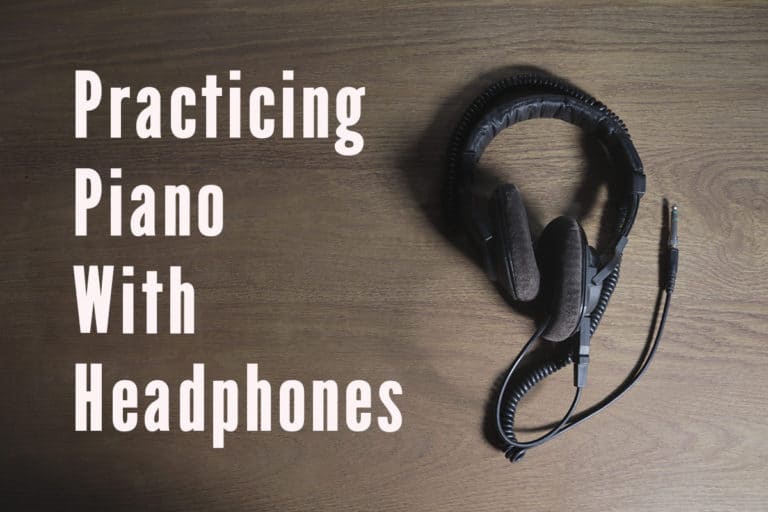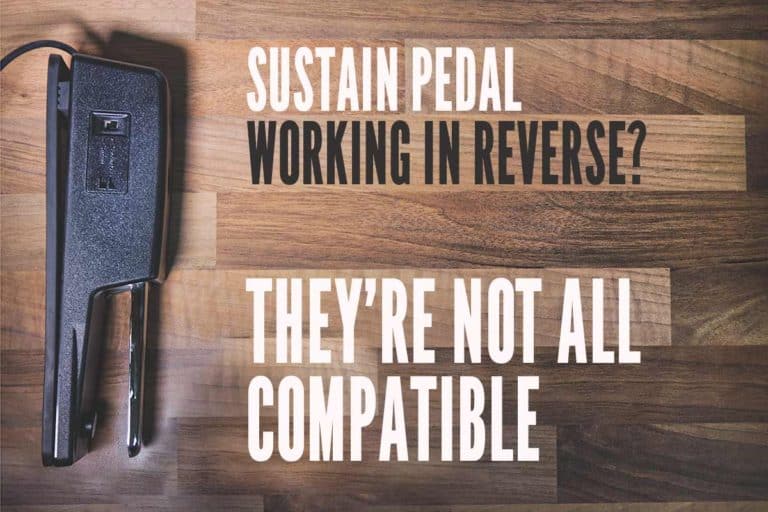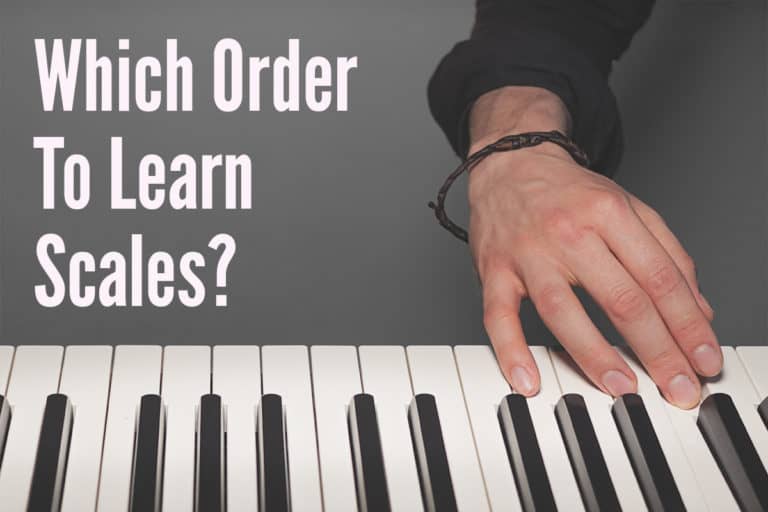How To Name The White Keys On Piano: A Detailed Guide To Practice And Memorize
This post contains affiliate links.
To learn piano, the first step you need to take is to get familiar with the keyboard and understand how we label the different notes, starting with the white keys. Although there’s many white keys, there’s actually only 7 different white notes, and then we have multiple higher and lower versions of them. Here’s how they work:
The 7 white keys are named using the letters A,B,C,D,E,F,G. These then loop and repeat along the keyboard. It’s easiest to find a C first which is the white key to the left of any block of 2 black keys. From there, they go in alphabetical order to the right, up to G and then start over at A.

How to navigate the piano keyboard
A standard piano has 88 keys, 52 white keys and 36 black. Black and white together, there’s 12 different notes which then repeat. That means we have multiple versions of each note starting low and getting high from left to right, respectively. We recognize the white keys by where they sit amongst the repeated pattern of a block of 2, then 3 black keys.


Just learn how to recognize C as a first step and get that memorized. Then you can start figuring out the other white keys from there, using C as a clear marker.
We need to learn the white keys first as the black keys then use those names but add on either a flat or sharp. You may be working with a smaller keyboard but the principles remain the same with a bit cut off either end. Focus on the middle region at first to avoid confusion learning the note names.
To start with, place one finger on a C and then move one white note a time to the right, naming each note aloud in alphabetical order along the way until you reach the next C. Remember to start the alphabet again at A after you reach G and along the way notice what each note looks like in the way it sits amongst the black keys. Eventually, you want to recognise these quickly and fluently so there’s some more practice tips later.
I have a clear 4 page PDF worksheet available on naming the white AND black keys available for you to have to hand in front of you at the piano whilst practicing.
Or if you prefer to learn with video, you can here on the piano from scratch YouTube channel:
Why we find the note C first
You may be thinking it’s most logical to start with A, but we usually find the note C first for a few reasons. Importantly, it’s visually clearer to see than A. C is also the starting note of the best first scale to learn on piano, the C major scale, which uses all the white notes from C to C. If you haven’t heard of a scale yet, that’s ok whilst we’re still learning note names. We also need to be able to find middle C. Middle C is the C that’s closest to the middle of your keyboard, whatever size you have and we use it as a marker to tell how high or low we are playing something on the piano.
Why different notes have the same name
I understand that sounds strange to have many higher and lower versions of the same note if you haven’t heard it before because they are all clearly different pitches that come from different keys. Whilst that is true, if you listen closely when you play a few different versions of the same note in different ranges, you’ll notice that there’s a quality to them that sounds very similar, like they’re connected in some way. The note C up to the next C for example, is said to be an ‘octave’ higher
Play a bunch of C’s in various octaves for a while and then you’ll really hear the difference when you suddenly throw in any other note. This is a really important concept to try and get used to in music. Sometimes you may want to play something in a particular range for a certain effect. A melody played high up may sound light and sparkly but if you played the exact same thing lower down, it may sound thicker and warm.
There is a scientific reason for this. The pitch of each note of the same name (an octave higher) is double the frequency of the last one. For example, if an A is 440HZ, the next A up is 880Hz, then 1760Hz and so on. There is a simple ratio of 2:1 to this pattern and our ears can detect that making them sound like lower and higher versions of the same note. There are also simple ratios between other notes that harmonize well together, liek a perfect 5th is 3:2 (This part is certainly not essential for learning the piano, it’s just very interesting).
Why you need to be able to find each note effortlessly
You will need to find a note before almost everything else that you do on the piano. That could be, learning a scale, playing a chord, reading sheet music as well as memorizing the notes of a song you want to play. The note names are a foundation that you need to make strong and if they’re not, you’re going to make everything else slower, harder and possibly tedious when it doesn’t need to be. Music is a language and everything you learn needs to be worked on so that eventually it can become internalized as part of your vocabulary. This is most true of the basics. That way, when you need something, (and you will need the note names all the time) it’s right there in your mind; you can access it with ease and without any mental barriers slowing you down from learning or being able to think musically and creatively.
It’s the difference between having a conversation in a language in which you are fluent where your thoughts just flow out, and struggling to ask a simple question in a language you kind of know fragments of. This may sound like overkill when we’re just talking about how to name the white notes but it’s an important attitude towards learning music that needs to start at the foundation if you want to be able to play with freedom, learn faster and retain more of that musical knowledge and ability.
As with everything you learn, this of course takes time so when I say it needs to feel effortless, don’t expect that to happen instantly and feel like you haven’t achieved something if it doesn’t yet, you just need to be working towards that. The more you use a skill, the more natural it will start to feel. You’ll practice this anyway because as I said you always use it, but isolating specific skills is a great way to make them stronger.
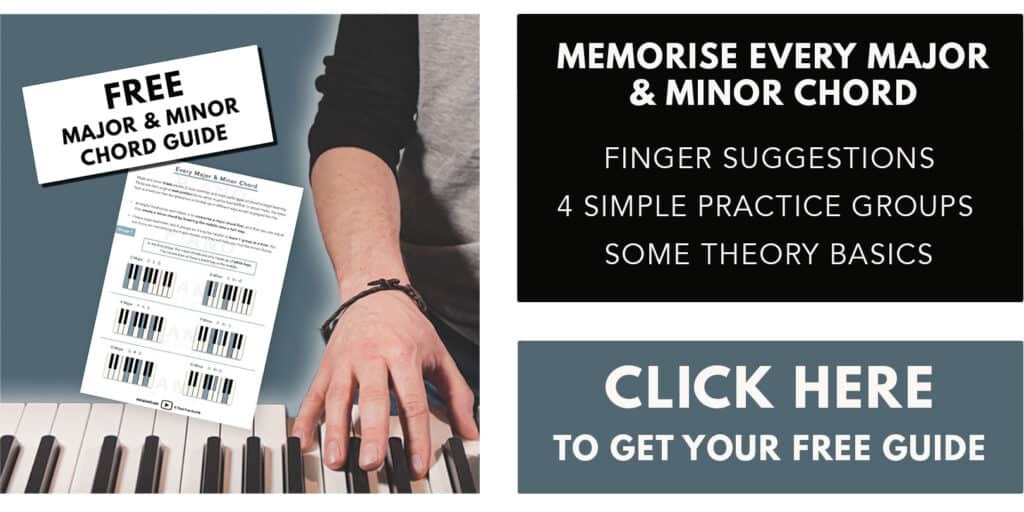
How to memorize notes on piano: 3 Practice methods
I like to use 3 steps with students to help them get familiar with the notes and be able to name them quickly and confidently. You can also apply this method to the black keys when you get there.
Step one: Going in order up and down and naming the notes
This is best to do first to start familiarising yourself with the keyboard, how the note names work and what each individual note looks like. Remember to use the black note blocks as a guide. Each white note will look different because of where it sits amongst the black keys. Start at C, go up (Right) to the next C, playing every note and back down.
- Use one finger to help you focus on the task at hand and not get fingers mixed up. If you haven’t played before, chances are you fingers will get in a muddle and it will throw you off what you’re really trying to do, learning the note names.
- Go slowly at first in order to let yourself digest the information better and reduce your chances of making a mistake. Practicing things too fast too soon is probably the no.1 beginner mistake so best to try and force a good habit early on.
- Say each note name out loud and really look at the note as you’re playing it to help build a strong connection in your brain between the name and what the note looks like. Try to avoid just reciting the alphabet on autopilot.
- Pay more attention on going backwards because it’s definitely the harder part. Go slower if you need to for this as I really forces you to have to think a bit more.
- Start trying to get faster. Once you are getting comfortable, try going up and down a little bit quicker to strengthen your familiarity.
- Go further using a wider range of notes or even the whole piano if you like. You could now also try starting and ending on different notes other than C which will force your brain to think about the notes more instead of just reciting the alphabet again
Step two: Naming notes at random
Once you have some basic familiarity with the notes it’s time to put that into some more real world like situations. The first is being able to name any note that you see whilst not already in the process of going up and down. You can still quickly go through the alphabet to figure out the answer at first but over time, that process will be super quick and then you won’t have to because you just recognise what note it is anyway. If you are by yourself, I recommend looking away or covering your eyes and then use one finger to blindly find a white note. Name that note as quick as you can and then rinse and repeat. Use the image above or the downloadable worksheet to check your answer. Over time see if you can speed up this process and you could also start off using a small range of notes and then get bigger for more of a challenge. Steps 2 and 3 may be easier if you have someone who could select the notes and check your answers for you but you could also use my play-along practice video.
Step three: Finding notes at random
This is just the reverse of step two, so name a note at random and then try to find it on the piano. It’s good to do this both ways as practically speaking, you will need to use both methods when learning and playing the piano. If you’re on your own, you can just select a note at random or perhaps draw note names out. Again, start slow, get faster, start with a small range then use more of the piano and use the image of the keyboard to check your answer. This step is also easier if you have someone to help name notes and check for you but if not, my practice video has this covered too.
My 4 page PDF worksheet is a clear recap of all of this information PLUS how to name the black keys that you can have in front of you at the piano
Still struggling? Here’s some more tips
If you’re still finding this tricky at all, there could be a few possible reasons. Check that you’re not trying to do it too quickly too soon because that is the number 1 beginner mistake which may end up in you learning the wrong thing by mistake. Go as slow as you need for it to feel manageable so that the information really starts to sink in. It might be that you’re trying to do too much in one go so with each practice step, try just doing it with C, D and E first until that feels easy. Then include F until it’s easy and keep adding one new note at a time until you can handle all of them. Lastly, maybe you just haven’t given it enough time yet. Expect some things to take time and practice, patience is honestly quite a big part of learning piano and it’s good to try and enjoy the process
A lot of newcomers to piano, learning on their own and going down the reading route have benefitted from the Alfred all in one method book series. You can check prices for book 1 on Amazon HERE or watch my detailed review on YouTube

